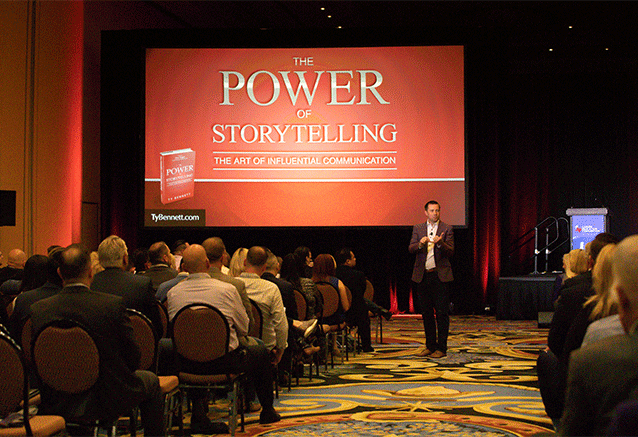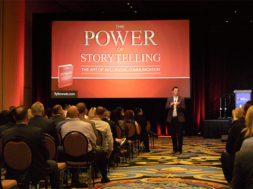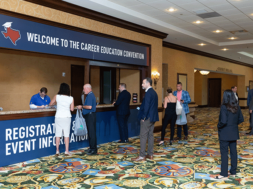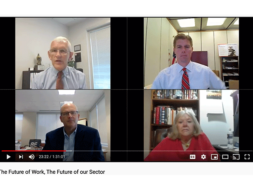
Keynote Speaker Ty Bennett Explains How to Become an Influential Storyteller
By Sara Klein written from the CECU Convention Keynote Session with Ty Bennett, Founder of Leadership Inc.
Ty Bennett was the keynote speaker at the CECU & CCST 2021 Career Education Convention, helping his audience learn how to effectively tell stories to show the impact they make in students’ lives. Bennett is the founder of Leadership Inc, a speaking and training company with a mission to “empower individuals and organizations to challenge their status quo, cultivate exceptional relationships, and compete in extraordinary ways.”
He began his keynote speech by explaining to his audience why the art of storytelling is so important and how it can impact listeners in positive ways.
“You have amazing stories to tell. And my goal in this session is [for you to be able to] flush out some of how we tell those stories so that you feel more confident, more capable, and more willing to tell those stories on a regular basis to sometimes shift the narrative … the way that you help students. The impact that you make in people’s lives, your stories of what you provide, the value that you give. You have stories coming out of COVID. You have all sorts of stories to tell, but we need to learn how to tell them well,” Bennett said.
“I believe that storytelling as a skill can be learned. I think that if you start to understand the nuances of it, you can start to understand how to flush it out.”
Bennett’s storytelling method can be broken down into three parts.
“First is the mindset, the approach that we take. Second is the skill set, how do we craft and influence a story? And third is the tool set, how do we make stories come alive,” Bennett explained.
Bennett described that your goal should not be to have a perfect presentation, which does not exist, but to work on creating a connection with the audience.
“When you shift your focus to the audience, you ask different questions, and different questions cause different emotions. This is not perfect, it never is. But here’s the thing; sometimes it feels perfect,” Bennett said. “Our goal should not be perfection, it’s connection, because when connection happens, all those imperfections don’t matter. And if that’s the case, then I think we have one purpose as we communicate and that’s engagement. How do we grab their attention? How do we make them a part of the story? How do we turn a presentation into where it feels like we’re connecting? That is so vitally important because without engagement, there’s never any influence.”
Bennett is passionate about the art of storytelling because storytelling works and it can cause many positive outcomes.
 “Here’s the definition that I love. A story is a reimagined experience narrated with enough detail and feeling to cause your listener’s imagination to experience it as real,” Bennett explained. “We don’t tell a story for us, we tell a story for them. And so if I can tell a story in a way that engages you emotionally, that captivates your imagination so you can see it, feel it, hear it, guess what, you’re more likely to act on it.”
“Here’s the definition that I love. A story is a reimagined experience narrated with enough detail and feeling to cause your listener’s imagination to experience it as real,” Bennett explained. “We don’t tell a story for us, we tell a story for them. And so if I can tell a story in a way that engages you emotionally, that captivates your imagination so you can see it, feel it, hear it, guess what, you’re more likely to act on it.”
One of the foundations for influential storytelling is that a person doesn’t retell a story, but instead relives a story, which invites others to relive it also. If a listener feels like part of the story, then he/she starts to really care about what happens in the story.
“Let’s start with bringing the audience into the story. There are three techniques that help bring the audience into the story. The first thing that I want you to do is I want you to create curiosity on the front end of the story. I have to tell you the truth and this is kind of a harder truth. Nobody cares about your story unless they see how it pertains to them,” Bennett said. “The way you get around that is you create curiosity on the front end of the story. The way that you do that is you ask a you-focused question on the front end of the story. A you-focused question has the word ‘you’ in the question and it brings you into the world of the story. Let’s take the Stephen Covey story for example. I said, ‘How many of you have ever read the book The 7 Habits of Highly Effective People?’ And virtually every hand in here went up. That was a you-focused question that created a commonality for that story to have relevance in your life.”
Bennett explained that the you-question technique is simple as it creates dialogue and connection on the front end just by asking a question. There are additional techniques he gave to incorporate the audience into the story.
“The second technique is I want you to place them in the scene. What happens in our minds, if I physically place you in the scene, is you start to visualize it. I’ll give you an example. I could say, ‘I don’t know if you’ve ever had to interview somebody, but the first time I ever did, I was so nervous. If you’d been sitting in my office with me, I’m sitting there behind my desk and my knees are shaking, the person’s walking in, I still don’t even know what I’m gonna ask him.’ Okay, pause for just a second. What do you picture right now? Are you picturing yourself behind me in an office? All I had to do to place you there is say, ‘If you’d been sitting in my office with me,’ just a simple line added to that to physically place you in the scene,” Bennett said.
“The third technique is for you to reinforce relatability. You do this by having a conversational tone in the way that you speak. You say things like, ‘Have you ever felt that before?’ or ‘Have you ever met somebody like that?’ It’s like you’re right here in the story.”
Bennett continued to give examples of how to engage your audience and how to keep it natural.
“The reality is, I don’t speak differently to one person than I do a thousand people. If you were to take any story, if before you jump into the story, you ask a you-focused question, tap into their world with the question, bringing them to your world with the story. Create a little bit of curiosity. Then they’re engaged,” Bennett said. “Then as you get into it, place them in the scene. Say, ‘Imagine being here.’ They can start to see it. And then maybe once or twice, you just reinforce relatability, like, ‘What would you do in that situation? And just little points within the story, all of a sudden it changes the user experience of the person listening. They’re in the story in a different way, because you’ve invited them to relive it with you. If you get nothing else out of this, I promise you, those three things will change how you tell stories in a huge way.”
In storytelling, Bennett explained that there is one major rule to follow, which is to keep the story as concise as possible.
“If it’s not necessary to say, it becomes necessary not to say. We are all very good at taking a two-minute story and telling it in five minutes. And nobody cares. The more concise you are, the more compelling it becomes,” Bennett said. “You do that by actually putting in some prep work, some practice. You might actually script out the story that you’re going to tell. You might practice it, role play it. Say it out loud a couple of times. Those things make such a difference.”

Bennett went out to explain that some people are resistant to this suggestion, worrying about sounding too robotic and not conversational enough.
“This is not the first time I’ve told these stories. I don’t think that you practice to memorize things, I think you practice to internalize things. There’s a difference between the two,” Bennett said. “If that’s part of you, then you can share it, and when you relive a story, that’s as much for the person listening as it is for you, because when you relive it, you can feel the emotion of it and share it like it’s the very first time, which allows you to connect in a different way.”
Bennett continued by beginning to explain the blueprint he has for the model for an influential story.
“I think the model for an influential story is struggle to solution. I think we hook people with the struggle and we help them with the solution. There is something in our bodies, in our DNA, that we respond to struggle, to conflict, to challenge. It naturally engages us,” Bennett said. “I learned this lesson from my three-year-old son. I told him the dumbest Smurfs story ever. I said, ‘Okay, the Smurfs woke up and it’s Smurfette’s birthday. And the baker guy made a cake and they sang happy birthday. Okay, go to bed.’ And he said, ‘That’s not a story. There’s no bad guy. Without a bad guy, it’s not a real story.’ And he was right.”
Bennett further explained that you need to be authentic and not just have a struggle for struggle’s sake.
“We don’t want to hear that your life sucks. We want to hear that it did suck and now it’s amazing. We want to see the transformational process,” Bennett said. “And here’s the thing, you provide the solution. If the struggle is relatable, the solution becomes credible. When we tell those stories from a struggle to solution standpoint, they have impact, and everything changes.”
Bennett continued by giving examples of ways to make these stories come alive.
“There are some tools that I think impact stories in a big way, and I call it the tool set. So let me give you a couple of tools that you can think about,” Bennett said.
“Dialogue makes a story come alive and if you want to relive a story, dialogue is one of the greatest ways to do that.”
He went on to explain how providing details is another tool to make the story come alive for the listener.
“The second tool I want you to think about is details. There are necessary details that make things more tangible, more real. Details that have to do with time, with location, with amount. Things that we can grab onto, those details matter,” Bennett said. “Let me give you an example [with] the story of Mel Fisher, the greatest treasure hunter that the world has ever known. He discovered the treasure of De Atocha off the Florida Keys worth over $400,000,000. All-in-all they found 700 silver bars that weighed 70 pounds apiece. Can you imagine? They found 2,500 emeralds, 3,500 other gems, hundreds of gold bars, and thousands of pounds of heavy gold discs, bits, and chains. Thousands of other artifacts. Or I could have simply said they found a really big treasure. Those details kind of matter, don’t they? They make it a little bit more real, and they make it a little more tangible.”
The last tool in the tool set, according to Bennett, is metaphors.
 “Sometimes in your world there are unique things that you are trying to explain that to the outside world are hard to grasp, because we don’t live in your world. And so finding the right metaphors that you can use in those stories becomes extremely important,” Bennett said. “I believe that is why when we say we have trillions of dollars of debt that means nothing to anybody, because what is that? You can’t feel that, you don’t even know what that feels like. If we want people to connect with that, then take those numbers and pull a specific person’s story out of it. It’s grabbing onto that individual story that makes a difference, that really helps people and that emotionally engages them and causes them to want to act or to move forward.”
“Sometimes in your world there are unique things that you are trying to explain that to the outside world are hard to grasp, because we don’t live in your world. And so finding the right metaphors that you can use in those stories becomes extremely important,” Bennett said. “I believe that is why when we say we have trillions of dollars of debt that means nothing to anybody, because what is that? You can’t feel that, you don’t even know what that feels like. If we want people to connect with that, then take those numbers and pull a specific person’s story out of it. It’s grabbing onto that individual story that makes a difference, that really helps people and that emotionally engages them and causes them to want to act or to move forward.”
Bennett gave a reminder to always keep the audience at the front of your focus.
“You guys have the same stories. You have your stories to tell. And as you start to think about it, I want you to remember, from a mindset perspective, your focus is on the audience. You tell a story for them. It’s not about you,” Bennett said. “Your goal is not perfection because that’s not attainable, but [instead your goal is] connection. When connection happens, all those imperfections don’t matter. Your purpose is to engage them, so don’t talk at them, talk with them. Make it conversational and find your voice and that balance between credibility and relatability.”
Bennett ended with a summary of the blueprint for influential storytelling.
“Stories should be relived not just retold. Stories are struggles to a solution. You hook them with a struggle, and you help them with the solution. Asking a focus question, creating a little bit of curiosity, tapping into their wardrobe of questions, bringing them into your world with the story, placing them in the scene,” Bennett said. “Reinforce that relatability. Add some dialogue, add some details, add some metaphors where they’re needed. That brings your stories to life. That makes your stories more compelling, more dynamic, more memorable.”
For more in-depth information on how to become a stronger storyteller, check out Ty Bennett’s book “The Power of Storytelling: The Art of Influential Communication,” available on Amazon.com in hard copy or electronic.



